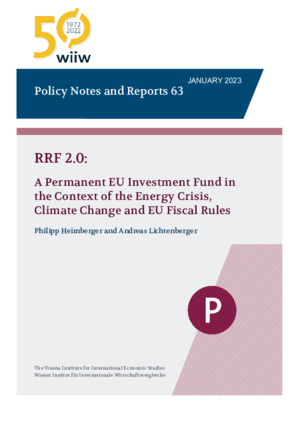RRF 2.0: A Permanent EU Investment Fund in the Context of the Energy Crisis, Climate Change and EU Fiscal Rules
Philipp Heimberger and Andreas Lichtenberger
wiiw Policy Note/Policy Report No. 63, January 2023
25 pages 6 Figures
While climate change has long called for a green shift in our economies, the current energy crisis leads to an increased urgency when it comes to transforming the energy and transportation systems. The Recovery and Resilience Facility (RRF), which was adopted to support recovery from the Covid-19 crisis, represents the first large-scale EU-wide investment initiative, including decarbonisation goals. Yet temporary RRF spending will not be sufficient to meet the climate targets in the coming decades, which will require additional public investment equivalent to at least 1% of EU economic output per year. Nor would the reform of EU fiscal rules under consideration enable a sufficient increase in public investment at the national level. What is needed is the establishment of a permanent EU climate and energy investment fund amounting to at least 1% of EU economic output to finance public investment, which could greatly enhance European sovereignty when it comes to ensuring strategic investment at the required scale. National budgets of EU member states would be substantially relieved, allowing governments to take an important step in the green transition while making it more realistic to comply with EU fiscal rules. Investment could also be increasingly directed toward genuinely European projects with EU added value. Such a permanent EU investment fund for climate and energy would not only strengthen the community of EU member states economically and politically from within, but also promote its geostrategic capacity to act.
Keywords: Investitionen, EU, Europa, Klimawandel, Energiekrise, Finanzierung, RRF 2.0
JEL classification: H54, H63, R42
Countries covered: Austria, European Union
Research Areas: Macroeconomic Analysis and Policy
